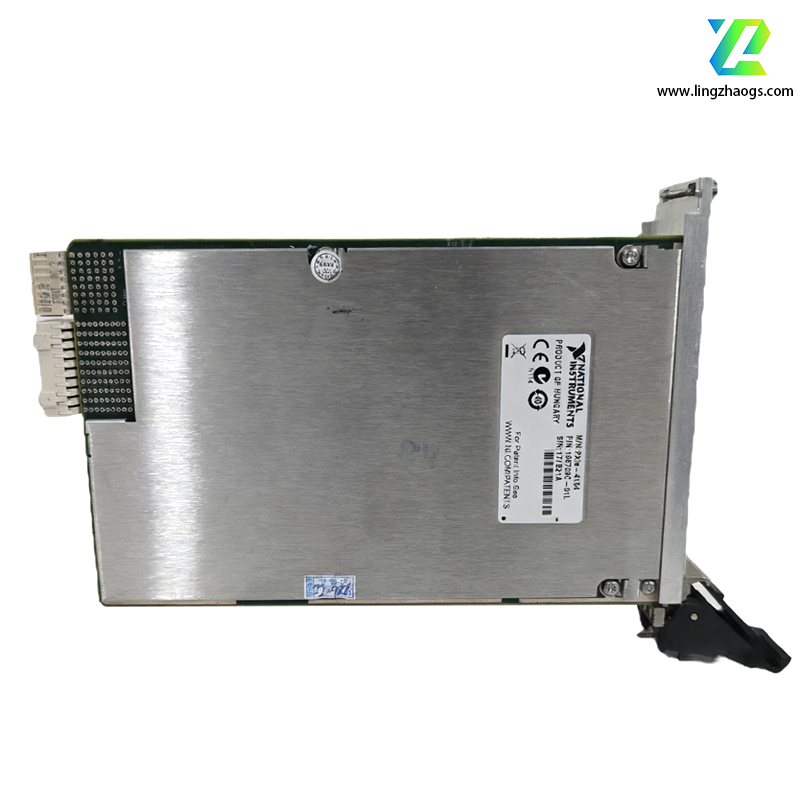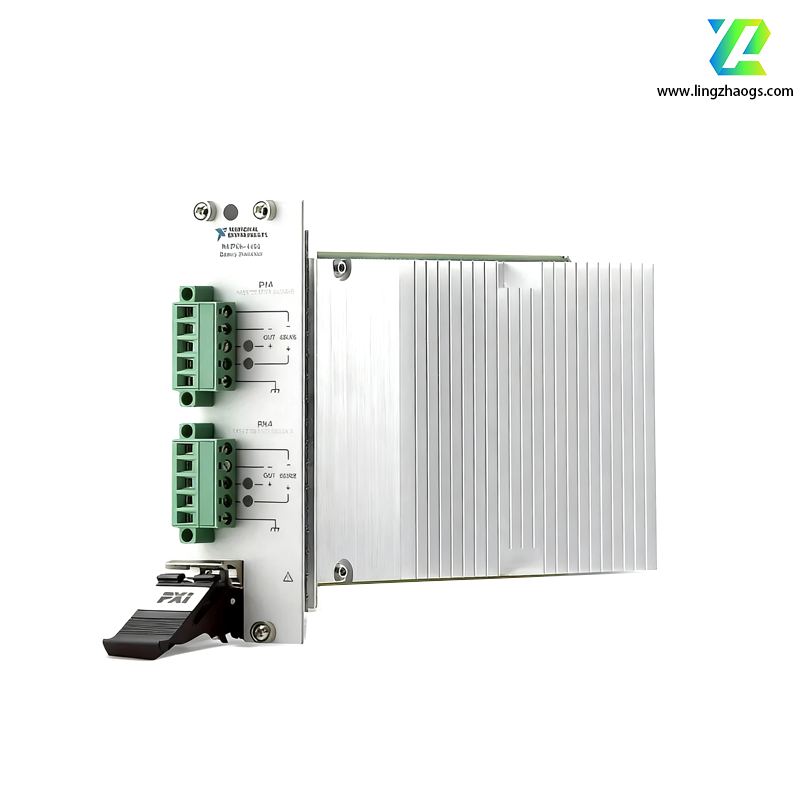The NI PXIe-4154 is a high-precision Source Measure Unit (SMU) designed for the PXI Express (PXIe) bus architecture, belonging to National Instruments (NI)’s precision DC measurement product line. Its defining features include wide voltage/current ranges (±210 V, ±1 A), femtoampere (fA)-level current measurement accuracy, and integrated source-sense functionality—making it ideal for low-power, high-precision testing scenarios such as semiconductor device characterization, battery cell testing, and sensor calibration. With PXIe’s high bandwidth and modularity, it enables scalable multi-channel test systems for R&D and production environments.
- Module Series: PXIe Precision SMU, optimized for DC source and measurement tasks
- Part Number: 783067-01 (standard model)
- Physical Dimensions: 2-slot 3U PXIe form factor, 20.3 cm × 16.0 cm (width × length)
- Weight: Approximately 1.5 kg (3.3 lbs)
- Power Requirements:
- +12 V DC (5.0 A)
- -12 V DC (1.0 A)
- +3.3 V DC (2.0 A)
- Power consumption: Typical 60 W, Maximum 80 W
- Interface Type:
- PXIe x1 lane (up to 8 GB/s data transfer rate) for high-speed command execution and data logging
- 2 SMA female connectors (HI/LO) for device under test (DUT) connection
- 1 26-pin D-Sub connector for auxiliary digital I/O and trigger signals
- Operating Temperature Range: 0°C ~ 55°C (commercial grade)
- Environmental Ratings:
- Shock Resistance: 50 g peak (11 ms duration, half-sine)
- Vibration Resistance: 2 g RMS (10 Hz ~ 500 Hz, random)
- Ingress Protection: IP30 (prevents solid foreign object intrusion)
- Compliance: Meets FCC Part 15 Class A, CE EN 61326-1, UL 61010-1, and IEC 61010-1 safety & EMC standards
- Current Measurement Sensitivity: Down to 10 fA (10⁻¹⁵ A), enabling low-leakage testing of semiconductor devices (e.g., MOSFET gate leakage)
- Voltage Regulation: ±0.001% of setpoint, ensuring stable voltage output for battery charging/discharging tests
- Settling Time: ≤1 ms (to within 0.1% of setpoint) for voltage/current changes, supporting fast transient response testing
- Temperature Coefficient: ±50 ppm/°C (max), minimizing accuracy drift in temperature-varying environments (e.g., industrial production lines)
- Output Noise: ≤10 µVrms (at ±10 V, 10 Hz ~ 100 kHz bandwidth), reducing interference for low-signal measurements (e.g., sensor calibration)
- Source Modes:
- Constant Voltage (CV): Programmable voltage with current limit (overcurrent protection)
- Constant Current (CC): Programmable current with voltage limit (overvoltage protection)
- Constant Power (CP): Programmable power with voltage/current limits (for battery or power device testing)
- Pulse Mode: Adjustable pulse width (10 µs ~ 10 s) and duty cycle (1% ~ 99%) to avoid DUT self-heating (e.g., LED forward voltage testing)
- Measurement Modes:
- DC Voltage (V): High-impedance measurement (10 GΩ input resistance)
- DC Current (I): Low-offset measurement with auto-ranging (100 µA ~ 1 A)
- Resistance (R): 4-wire (Kelvin) measurement to eliminate lead resistance errors (10 Ω ~ 2.1 GΩ)
- Power (P): Real-time calculation of V×I with 1 µW resolution
- Clock Sources:
- Internal: 100 MHz precision oscillator (stability ±0.01 ppm/year)
- External: 10 MHz reference input (via auxiliary connector) for system-wide timing alignment
- PXIe 10 MHz Backplane Clock: Synchronizable with other PXIe modules (e.g., PXIe-4153 SMUs, PXIe-5632 VSAs)
- Trigger Options:
- Digital Trigger: TTL-compatible edge trigger (rising/falling) via auxiliary I/O or PXIe trigger lines (PXIe_Trig 0~7)
- Analog Trigger: Trigger on voltage/current threshold (e.g., trigger measurement when DUT current exceeds 10 mA)
- Software Trigger: API-initiated trigger for automated test sequences (via LabVIEW or Python)
- Multi-Module Sync: Supports PXIe Star Trigger for nanosecond-level synchronization of up to 16 PXIe-4154 modules (for multi-channel DUT testing, e.g., battery packs)
- Overcurrent Protection (OCP): Programmable current limit (100 µA ~ 1 A) with auto-recovery or latch-off mode
- Overvoltage Protection (OVP): Programmable voltage limit (10 V ~ 210 V) to prevent DUT damage
- Overpower Protection (OPP): Power limit (1 W ~ 210 W) for high-power device testing
- Reverse Polarity Protection: Built-in diode to prevent damage from reversed DUT connections
- Thermal Protection: Auto-shutdown at 70°C (max) to avoid module overheating
- Recommended Software:
- NI-DCPower Driver (required for low-level hardware control and mode configuration)
- LabVIEW 2020+ (for custom test program development and GUI design)
- NI TestStand (for test sequence automation, data logging, and report generation)
- NI Switch Executive (for integrating with switch matrices to expand channel count)
- Programming Compatibility:
- NI Ecosystem: Native support for LabVIEW, LabWindows/CVI, and Measurement Studio
- Third-Party Languages: Supports C/C++, C#, Python (via NI-DCPower Python bindings), and MATLAB (via NI-DCPower Toolbox)
- Scripting: Supports Python and LabVIEW scripting for rapid test setup (e.g., batch testing of 100+ DUTs)
- Calibration Tools:
- Built-in automated calibration (via NI-DCPower) for gain, offset, and linearity correction
- Recommended calibration interval: 1 year (or after major temperature changes)
- External calibration support via NI Calibration Services (ISO 17025 accredited)
The NI PXIe-4154’s wide range and high precision make it ideal for:
- Semiconductor Testing: MOSFET/IGBT characterization (leakage current, breakdown voltage), IC power consumption measurement (standby/sleep mode current), and wafer-level testing
- Battery & Energy Storage: Lithium-ion battery cell testing (charge/discharge cycles, capacity measurement, internal resistance calculation), supercapacitor characterization
- Sensor Calibration: Low-power sensor testing (e.g., MEMS accelerometers, pressure sensors), current-to-voltage conversion for photodiode sensors
- Passive Component Testing: Resistor (4-wire Kelvin measurement), capacitor (leakage current), and inductor (DC resistance) testing
- Aerospace & Defense: Avionics component power testing (low-leakage connectors, high-voltage relays), satellite battery pack characterization (low-temperature performance)
- Ideal Use Cases: Applications requiring ±210 V/±1 A range, fA-level current measurement, and PXIe modular integration; suitable for R&D, production test, and calibration labs
- Comparison with Similar Models:
- vs. NI PXIe-4153: PXIe-4154 offers wider voltage range (±210 V vs. ±60 V) but lower maximum current (1 A vs. 3 A); choose for high-voltage, low-current testing
- vs. NI PXIe-4162: PXIe-4154 has higher precision (fA vs. nA) but lower channel count (1 channel vs. 2 channels); ideal for single-channel high-precision tasks
- System Integration:
- Chassis Compatibility: Requires NI PXIe chassis with 2 available slots (e.g., PXIe-1075, PXIe-1085) or third-party PXIe-compliant chassis
- Companion Modules:
- Switch Matrix: Pair with NI PXIe-2597 (64×4) to expand to multi-channel testing (e.g., 32 battery cells)
- Temperature Chamber Control: Integrate with NI PXIe-6358 (DAQ) to monitor DUT temperature during testing
- Data Logging: Use NI PXIe-8235 (Ethernet) to stream measurement data to a server
- Limitations: Single-channel design (requires multiple modules for multi-DUT testing); no AC source/measurement capability (use NI PXIe-5632 for AC signals)
- Alternative Models:
- Higher Current: NI PXIe-4153 (±60 V, ±3 A)
- Multi-Channel: NI PXIe-4162 (2 channels, ±20 V, ±1 A)
- Lower Cost: NI USB-4140 (USB interface, ±10 V, ±100 mA, entry-level)



